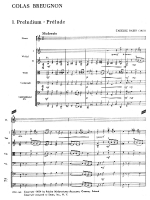Colas Breugnon. A suite in the old style for string orchestra and flute (1951)
The composition was based on Baird’s incidental music to a radio play, Colas Breugnon, after Romain Rolland’s story.
The Suite consists of six movements: I. Prelude (Prélude), II. Love cantilena (Cantilène d’amour), III. Dance I (Basse danse), IV. Sad song (Chant triste), V. Dance II (Gaillarde), VI. Postlude (Postlude)
In movements III and V the composer used two single-voice melodies from the 16th century (from the collection Quatorze Gaillardes), composing new themes for the remaining movements. The Suite is an excellent example of archaisation with elements of folk stylisation. Archaisation in the piece draws on solutions used in Renaissance (movements III and V), Baroque and classical (I and VI) as well as Romantic music (II and IV). This makes the expressive contrast between successive movements very clear. The Suite has a subtle sound resulting from a juxtaposition of a chamber string orchestra with solo flute (movements I, III and VI). The dominant means of stylisation is freely treated major-minor harmony, coloured by numerous fourth-fifth parallelisms. What is clearly in evidence is a richness of deceptively resolved sixth and seventh chords.
Given its huge popularity, the Suite deserves to be called a hit among all of composer’s works, the symbol of which is the title of Coca-Cola Breugnon, given to the work by the conductor Andrzej Markowski. According to the critics, it is an outstanding work in a marginal strand of Baird’s output.
Colas Breugnon has a ballet version, presented in 1963, at Warsaw’s Teatr Klasyczny, as part of a poetic-ballet production entitled Love Sonnets and directed by Jan Kulczyński. The work won the composer the Award of the Minister of Culture and Art at the 2nd Polish Music Festival (1955).









